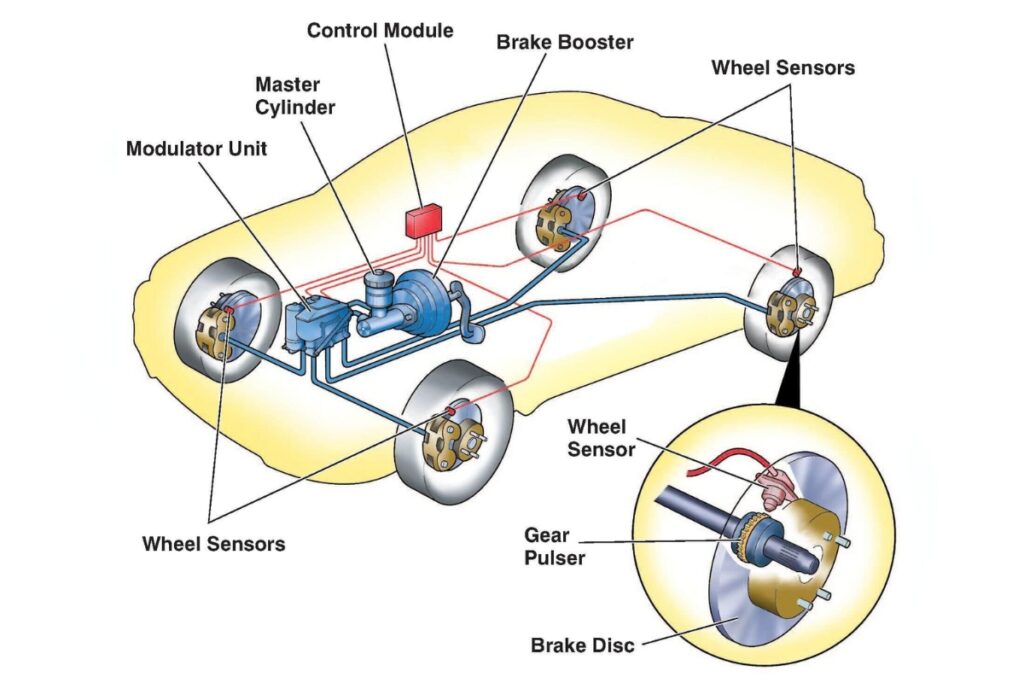Imagine you’re driving down a slick, rain-soaked road when suddenly, you need to slam on the brakes to avoid a collision. The last thing you want is for your car to skid uncontrollably. Enter the ABS System, swiftly modulating brake pressure to maintain control, preventing your vehicle from turning off course.
So, the ABS is like a safety net for your wheels, ensuring you stay on course even in the most challenging driving conditions. But how does the ABS braking system work? What are the advantages? And, most importantly, how can you keep this auto part running smoothly?
Let’s take a closer look at what makes this car part indispensable, the common issues it faces, and why staying on top of maintenance matters.
What is the ABS?
The ABS (Anti-lock Braking System) is a sophisticated safety feature that prevents wheel lock-up during emergency braking. Its primary function is to maintain traction and steering control, even in slippery or adverse road conditions.
When you apply the brakes suddenly, the ABS detects if any of the wheels are about to lock up by monitoring their speeds. If it detects an impending lock-up, it modules brake pressure to that wheel, preventing it from skidding.
By pulsating the brakes rapidly, the ABS ensures that the wheels maintain traction with the road surface, allowing you to steer the car while braking. This intervention helps you avoid obstacles and maintain control, reducing the risk of accidents.
Basically, the ABS acts as a safety net, providing drivers with the confidence to brake hard in emergencies without fear of losing control. It’s a crucial part of modern vehicles’ braking systems, contributing significantly to overall safety on the road.

What are the ABS System elements?
For the ABS to work, there are six major components in the system:
- ABS speed sensor: responsible for defining the speed of each wheel and sending signs to the ECU.
- Rotation sensors: provide information to the ABS module when one of the wheels begins to brake.
- ABS Control Unit: checks the rotation sensors and reacts to the signals from the speed sensors.
- Valves: there is a valve in the piping of each brake controlled by the ABS module, responsible for lowering and releasing the brake pressure.
- Pump: are filled with hydraulic fluid that applies pressure to the brake drums or calipers when brakes are applied.
- Brake fluid: transfers force from the hydraulic lines to the braking mechanism near the wheels. As brakes produce a lot of heat, the brake fluid has a high boiling point for effective operations. It also prevents corrosion of the materials in contact.
What are the advantages of the ABS?
The ABS offers several benefits that enhance safety and performance on the road:
- Shorter braking distance: By bringing your car to a halt more efficiently, the ABS reduces stopping distances, which is crucial for avoiding collisions, especially in emergencies.
- Prevents uneven tire wear: With ABS in action, your wheels don’t lock up during braking, preventing uneven tire wear. This ensures that your tires maintain optimal grip and longevity.
- Reduces wear on brake components: Traditional braking systems can subject brake pads and discs to excessive wear (which can make you replace them quicker). ABS mitigates this issue by regulating brake pressure and reducing wear and tear on these critical components.
In summary, ABS isn’t just about stopping your car – it’s about doing so safely and efficiently. From shorter braking distances to reduced wear on critical components, the advantages of ABS make it an indispensable feature for any vehicle.

What are the common failures of the ABS System?
Despite their reliability, these auto parts aren’t immune to trouble. It’s crucial to know the most common failures in the ABS System so you can prevent or solve them quickly.
Sensor Malfunctions
One of the primary issues encountered with ABS Pumps is sensor malfunctions. Over time, sensors can become contaminated with dirt, debris, or brake fluid, leading to inaccurate readings. When sensors fail to detect wheel speed correctly, the ABS may engage unnecessarily or fail to activate when needed, compromising overall braking performance.
Pump Failures
Another common problem is pump malfunctions. The ABS Pump comprises various mechanical and electronic components that can wear out over time or stop working. Pump failures can manifest as a loss of ABS functionality, resulting in a mushy brake pedal or complete brake failure in extreme cases. This is a significant safety risk and warrants immediate attention.
Electrical Issues
Electrical gremlins can also rear their heads in ABS systems, causing intermittent ABS warning lights or erratic ABS behavior. Wiring harnesses, connectors, and control modules are susceptible to corrosion, abrasion, or poor connections, leading to communication errors within the ABS.
Maintenance Matters
In light of these potential issues, proactive maintenance of your car‘s ABS is essential. Regular inspections, sensor cleaning, and diagnostic checks can help identify and address issues before they escalate into major problems. If you notice unusual noises, warning lights, or diminished braking performance, seek professional assistance. Remember, a well-maintained ABS is your best defense against surprises on the road.

